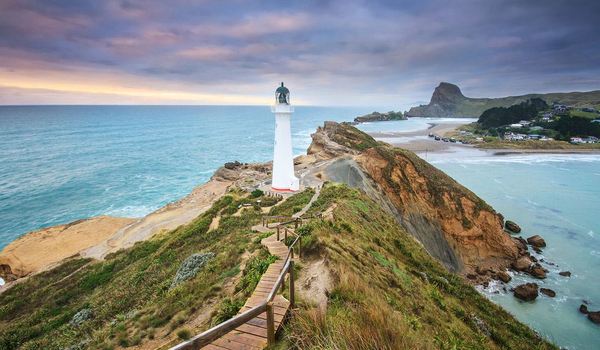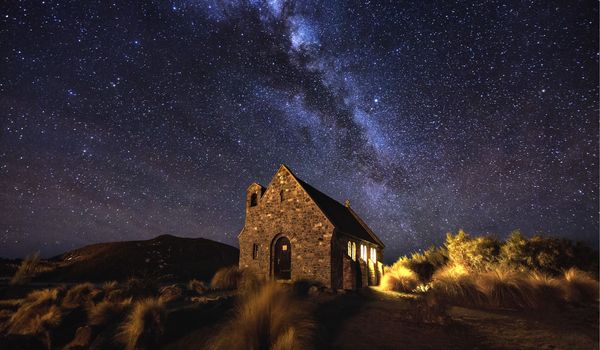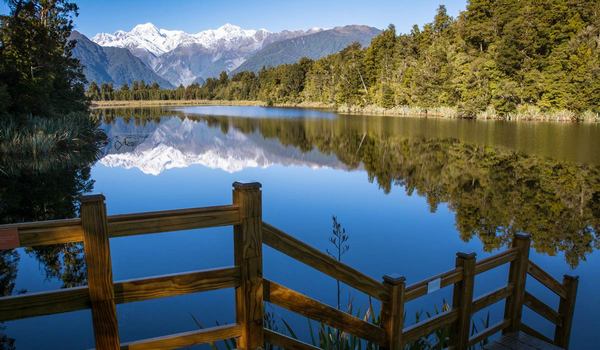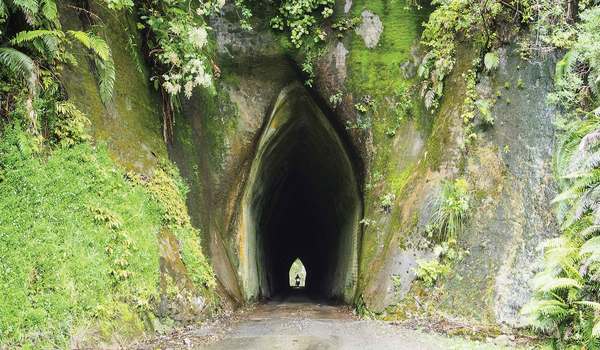🏞 Introduction to The Most Interesting Hidden Gems in New Zealand
New Zealand holds a trove of lesser-known treasures and hidden lakes waiting to be explored.
Beyond the popular destinations lie hidden gems that promise unique experiences.
- From secluded beaches and charming towns to off-the-beaten-path hiking trails, we will explore in this article hidden gems that add an extra layer to a Kiwi adventure.
1. Whanganui River
Hidden on New Zealand’s North Island, the Whanganui River offers a serene and enchanting escape. This majestic waterway is often called the “Rhine of New Zealand” due to its meandering beauty.
You can explore it by taking a multi-day canoe or kayak trip, immersing yourself in the pristine wilderness of Whanganui National Park.

📌 Some interesting facts about the Whanganui River:
-
- Cultural Significance: The Whanganui River holds significant cultural importance for the local Maori people, and it has been granted legal personhood, a unique recognition that emphasizes its cultural significance.
- Historical Background: The river has a rich history, playing a vital role in the region’s trade and transportation in the past. Understanding its historical context adds depth to the experience.
- Flora and Fauna: The Whanganui National Park surrounding the river is home to diverse flora and fauna. Watch for native bird species and unique plant life during your journey.
- Local Guides: Consider hiring local guides who can provide insights into the area’s history, culture, and ecology. They can enhance your experience and ensure a safer journey.
- Accommodation Options: Plan accommodation options along the river or nearby towns to plan your stay. This could include campsites, lodges, or traditional Maori marae experiences.
- Best Times to Visit: Check the optimal seasons for visiting. Different times of the year offer distinct experiences, from vibrant autumn foliage to warm summer weather.
- Safety Tips: Prioritize safety by wearing appropriate gear, understanding river conditions, and being aware of potential hazards. Familiarize yourself with safety guidelines for canoeing or kayaking.
- Cultural Etiquette: Respect the local culture and follow any cultural protocols. This may include asking for permission before entering certain areas or treating the environment carefully.
- Photography Opportunities: Bring a camera to capture the breathtaking scenery. Sunrise and sunset are magical times to photograph the river and surrounding landscapes.
2. Castlepoint Lighthouse
Located on the southern Wairarapa coast of the North Island, Castlepoint is a picturesque coastal village known for its dramatic Castle Rock and the charming Castlepoint Lighthouse.
One of the hidden gems that offers stunning views of the Pacific Ocean, and the walk to the lighthouse takes you through scenic farmland and over rocky terrain.

📌 Some interesting facts about the Castlepoint Lighthouse:
- Construction and Establishment: Castlepoint Lighthouse was constructed in 1913 and was officially commissioned on January 12, 1914.
- Design and Architecture: The lighthouse is a steel tower with a height of 23 meters (75 feet). It stands on Castle Rock, providing a dramatic and picturesque setting.
- Guiding Mariners: The primary purpose of Castlepoint Lighthouse is to guide ships along the treacherous coastline, helping mariners navigate the waters safely.
- Light Characteristics: The lighthouse emits a white flash every 10 seconds, and its light can be seen up to 22 nautical miles offshore.
- Unique Color Scheme: Unlike many traditional white lighthouses, Castlepoint is painted black and white, creating a distinctive appearance against the coastal backdrop.
- Automation: Castlepoint Lighthouse was automated in 1954, meaning that it no longer requires a resident lighthouse keeper for its operation.
- Scenic Surroundings: The lighthouse offers panoramic views of the surrounding coastline, the Pacific Ocean, and the village of Castlepoint, making it a popular spot for both locals and tourists.
- Geological Significance: Castle Rock, on which the lighthouse stands, is a remnant of an ancient volcano, adding a geological dimension to the site’s appeal.
- Movie Filming Location: Castlepoint and its lighthouse have served as a filming location for movies and television shows, contributing to its cultural and cinematic significance.
- Public Access: Visitors can climb to the top of Castlepoint Lighthouse during certain hours to enjoy breathtaking views of the surrounding landscape.
- Maori Name: The Maori name for Castlepoint is Rangiwhakaoma, which reflects the cultural heritage and connection of the Maori people to the land.
- Frequent Storms: The lighthouse has withstood various storms and harsh weather conditions over the years, showcasing its durability and resilience.
3. Lake Tekapo and the Church of the Good Shepherd
While Lake Tekapo is relatively well-known, the nearby Church of the Good Shepherd often goes unnoticed.
This charming stone church is perched on the edge of the lake, offering breathtaking views of the Southern Alps and the night sky. It’s a prime spot for stargazing and astrophotography, thanks to its designation as a Dark Sky Reserve.

📌 Some interesting facts about the Church of the Good Shepherd:
- Location: The Church of the Good Shepherd is located on the shores of Lake Tekapo in the South Island of New Zealand, offering stunning views of the lake and the surrounding mountains.
- Construction Year: The church was built in 1935 as a memorial to the pioneers of the Mackenzie region.
- Architectural Style: The church is constructed in a simple, iconic style with stone walls and a distinctive small, square bell tower.
- Panoramic Altar View: One of the unique features of the church is its altar window, which frames a picturesque view of the Southern Alps, providing a stunning backdrop during ceremonies.
- Dark Sky Reserve Designation: The Church of the Good Shepherd is situated in the Aoraki Mackenzie International Dark Sky Reserve, making it an excellent location for stargazing.
- Windows Symbolism: The church features beautiful stained-glass windows, with one depicting a shepherd and another representing the four seasons.
- Popular Wedding Venue: Due to its scenic location and charming atmosphere, the Church of the Good Shepherd is a popular choice for weddings, drawing couples worldwide.
- Open Design: The church is intentionally designed to provide a relaxed and welcoming space, reflecting the hospitable spirit of the local community.
- Memorials and Artifacts: Inside the church are memorials dedicated to the pioneers of the region, as well as artifacts showcasing the area’s history.
- Interdenominational Use: The church is an interdenominational place of worship, welcoming people of all denominations and backgrounds.
- Community Involvement: The Church of the Good Shepherd is integral to the Lake Tekapo community, hosting various events and services throughout the year.
- Photography Hotspot: The church is a favorite subject for photographers, especially during sunrise and sunset, when the changing colors of the sky enhance its beauty.
- Conservation Efforts: Efforts are made to preserve the natural surroundings of the church, ensuring that the pristine beauty of Lake Tekapo and its environs remains intact.
- Symbol of Peace: The church is often regarded as a symbol of peace and tranquility, offering a serene place for reflection and spiritual connection.
4. Nugget Point
Nugget Point is one of the hidden places of rugged beauty and captivating wildlife on the southeastern coast of New Zealand’s South Island.
The highlight is the iconic Nugget Point Lighthouse, surrounded by stunning rock formations known as “nuggets.” It’s a fantastic spot for watching seals, sea lions, and a variety of seabirds in their natural habitat.

📌 Some interesting facts about the Nugget Point:
- Location: Nugget Point is situated in the Catlins region of the South Island, overlooking the Pacific Ocean. It’s known for its dramatic coastal scenery.
- Nuggets: The point comes from the rocky islets or “nuggets” scattered just offshore. These weathered rocks resemble gold nuggets, giving the area its distinctive character.
- Lighthouse: The Nugget Point Lighthouse, built in 1869, stands proudly on the headland. It is one of the oldest lighthouses in New Zealand and has been guiding ships through these waters for over a century.
- Wildlife Sanctuary: Nugget Point is a haven for seabirds and marine life. Visitors can often spot fur seals and sea lions basking on the rocks, as well as various seabird species, including gulls and shags.
- Viewing Platform: A well-maintained viewing platform provides breathtaking panoramic views of the coastline, lighthouse, and nuggets. It’s a popular spot for photography and whale watching.
- Geological Features: The coastal cliffs and rugged rocks at Nugget Point showcase fascinating geological formations. Erosion has sculpted the landscape, creating intricate patterns and shapes in the cliffs.
- Historical Significance: The area around Nugget Point has historical significance, with stories of shipwrecks and early maritime activities adding to the site’s allure.
- Walking Track: Visitors can enjoy a scenic walking track that leads to the lighthouse and offers spectacular views. The track is relatively easy, making it accessible to many visitors.
- Sunrise and Sunset Views: Nugget Point is renowned for its stunning sunrise and sunset views. The changing colors of the sky against the rugged coastline make it a favorite spot for photographers.
- Conservation Efforts: Conservation initiatives are in place to protect the natural habitat around Nugget Point and ensure the well-being of the wildlife that inhabits the area.
- Cultural Connection: The Maori people have cultural ties to the land around Nugget Point, adding a layer of cultural significance to this coastal gem.
- Accessibility: Nugget Point is easily accessible by road, and the journey to reach the point itself offers picturesque scenery, including rolling hills and coastal vistas.
5. Lake Waikaremoana
Hidden deep within Te Urewera National Park on the North Island, Lake Waikaremoana is a tranquil wilderness haven. The Great Walk that encircles the lake takes you through ancient forests, past cascading waterfalls, and panoramic viewpoints.
This is one of the hidden gems that offers a remote and pristine escape for hikers and nature enthusiasts.

📌 Some interesting facts about Lake Waikaremoana:
- Maori Cultural Significance: The name “Waikaremoana” is of Maori origin and translates to “sea of rippling waters” or “sea of the glowing horizon.”
- Formation: Lake Waikaremoana was formed over 2,200 years ago by a massive landslide. The landslide dammed the Waikaretaheke River, creating the lake as it is known today.
- Size and Depth: It is the third-largest lake in New Zealand, covering an area of approximately 54 square kilometers. The lake is quite deep, reaching a maximum depth of around 248 meters (814 feet).
- Te Urewera National Park: Lake Waikaremoana is located within Te Urewera National Park, a protected area known for its diverse flora and fauna.
- Great Walk: The Lake Waikaremoana Track is one of New Zealand’s Great Walks. It is a popular hiking trail that takes visitors on a 46-kilometer (29-mile) journey around the lake, offering stunning landscape views.
- Unique Fauna: The lake is home to various bird species, including the kiwi, kaka, and tui. The surrounding forested areas are rich in biodiversity.
- Trout Fishing: Lake Waikaremoana is renowned for its trout fishing. Anglers visit the lake to try their luck at catching rainbow and brown trout.
- Scenic Beauty: The lake is surrounded by lush forests, waterfalls, and panoramic viewpoints. Rugged hills and pristine wilderness characterize the landscape.
- Water Quality: The water of Lake Waikaremoana is known for its clarity and purity. The lake is a source of drinking water for nearby communities.
- Weather and Climate: The climate around Lake Waikaremoana can vary, but generally, the region experiences mild temperatures. Rainfall is relatively high, contributing to the lush greenery.
- Cultural Heritage Sites: The lake area contains several cultural heritage sites, including ancient Maori carvings and rock art that reflect the region’s rich history.
6. Pancake Rocks and Blowholes
On the West Coast of the South Island, Punakaiki is home to the fascinating Pancake Rocks and Blowholes. The layered limestone formations resemble stacks of pancakes, and when the tide is right, water sprays dramatically through the blowholes.
This natural spectacle is a true wonder of nature, and the adjacent Paparoa National Park offers opportunities for further exploration.

📌 Some interesting facts about Pancake Rocks and Blowholes:
- Formation of Pancake Rocks: Pancake Rocks are limestone formations that have been sculpted by the erosive forces of the Tasman Sea over millions of years.
- Limestone Composition: The rocks are made up of layers of limestone that accumulated over time from the remains of marine organisms, such as shells and skeletons.
- Erosion Patterns: The unique pancake-like appearance results from differential erosion, where softer rock layers erode more quickly than harder ones. This creates distinct, stacked layers.
- Blowholes: Blowholes are natural openings in rock formations that allow seawater to be forced upward during high tide or when waves crash into the rocks.
- Punakaiki Blowholes: The Punakaiki Pancake Rocks are particularly well-known for their blowholes, with the seawater shooting up through the gaps in the rocks, sometimes reaching several meters.
- Tidal Influence: The activity of blowholes is often influenced by the tide, with the most spectacular displays occurring during high tide and stormy weather.
- Wildlife and Vegetation: The area around Pancake Rocks is home to diverse flora and fauna, including native New Zealand plants. Visitors might spot various seabirds and marine life in the vicinity.
- Tourist Attraction: Pancake Rocks and Blowholes are popular tourist attractions, drawing visitors worldwide to witness the unique geological formations and the dynamic display of water shooting through the blowholes.
- Conservation Efforts: Due to the limestone formations’ delicate nature, efforts are in place to preserve and protect Pancake Rocks. Boardwalks and viewing platforms are provided to allow visitors to enjoy the site while minimizing impact.
7. Lake Matheson
Nestled near Fox Glacier on the South Island, Lake Matheson is famous for its mirror-like reflections of Aoraki (Mount Cook) and Mount Tasman. An easy walking trail encircles the lake, providing breathtaking vistas of the snow-capped peaks.
It’s a serene and magical hidden place, especially during sunrise or sunset when the mountains are bathed in a golden glow.

📌 Some interesting facts about the Lake Matheson:
- Mirror Lake: Lake Matheson is often referred to as the “Mirror Lake” due to its still waters that create perfect reflections of the nearby Southern Alps, including New Zealand’s highest peaks—Aoraki/Mount Cook and Mount Tasman.
- Maori Name: The Māori name for Lake Matheson is “Tāwhai-ā-āne,” which refers to a sacred place associated with the ancestors.
- Glacial Origins: The lake was formed by glaciation during the last ice age. As glaciers retreated, they left depressions in the landscape that later filled with water, creating the lake.
- Dark Waters: The dark color of the lake’s water is due to organic matter leached from the surrounding native vegetation. This contributes to the reflective qualities of the lake.
- Walking Tracks: Well-maintained walking tracks around Lake Matheson offer different perspectives of the mirror-like reflections. The most popular track is the Lake Matheson Walkway, which takes about 1.5 to 2 hours to complete.
- Rahotu: The nearby settlement of Rahotu serves as a gateway to Lake Matheson, providing accommodations and facilities for visitors exploring the area.
- Flora and Fauna: The lake and its surroundings are home to various native plants and wildlife. Birdwatchers may spot species such as the native wood pigeon (kererū) and tui in forest areas.
- Photography Hotspot: Lake Matheson is a favorite spot for photographers, especially during sunrise and sunset when the changing light conditions enhance the reflections and create breathtaking scenery.
- Reflection Island: In the middle of Lake Matheson, a small, partially submerged island is known as “Reflection Island.” It adds to the composition of the reflections on the lake’s surface.
- Conservation and Protection: Due to its ecological and scenic significance, Lake Matheson and its surrounding area are protected, and efforts are made to preserve the natural beauty of the lake and its ecosystem.
- Weather Dependence: The quality of the reflections highly depends on the weather conditions. Clear, calm days provide the best opportunities to witness the mirror effect.
8. The Forgotten World Highway
For an unforgettable road trip experience, embark on the Forgotten World Highway in the North Island. This remote and scenic route takes you through lush rainforests, past forgotten towns, and across historic one-lane bridges.

📌 Some interesting facts about the Forgotten World Highway:
- Location: The Forgotten World Highway is located in the Taranaki and Manawatu-Wanganui regions of the North Island, connecting Stratford to Taumarunui.
- Distance: The highway spans approximately 150 kilometers (93 miles) and takes travelers through remote and rugged terrain.
- Historical Significance: The route has historical significance, following an old bridle trail used by early Māori and European settlers.
- Unsealed Sections: The Forgotten World Highway parts are unsealed (gravel), adding an adventurous and rustic element to the journey. Travelers should be prepared for varying road conditions.
- Whangamomona Republic: One of the highlights along the highway is the Republic of Whangamomona. In 1989, residents declared their independence as a protest against local government restructuring. The republic has its own president and even issues passports (for fun).
- Whangamomona Hotel: The Whangamomona Hotel, located in the Republic of Whangamomona, is a popular stopping point for travelers. The hotel has a quirky atmosphere and is a hub for visitors exploring the area.
- Moki Tunnel: The Moki Tunnel is a one-lane tunnel carved through solid rock. It adds a unique element to the journey and is one of the notable landmarks along the highway.
- Tangarakau Gorge: The highway passes through the picturesque Tangarakau Gorge, offering stunning views of the rugged landscapes and the Tangarakau River.
- Historical Sites: Travelers can explore sites along the Forgotten World Highway, including old settlements and remnants of the region’s pioneering past.
- Scenic Beauty: The highway winds through diverse landscapes, including farmland, forests, and hills. Panoramic views of the surrounding countryside make it a scenic drive.
- Railway Heritage: The route follows the path of the decommissioned Stratford-Okahukura railway line, adding an extra layer of historical interest.
- Adventure Tourism: The Forgotten World Highway has become popular for adventure tourism, attracting motorcyclists, cyclists, and road trip enthusiasts seeking a unique and off-the-beaten-path experience.
- Limited Services: Travelers should be aware that services along the highway are limited, so it’s advisable to plan accordingly and ensure the vehicle is well-equipped for the journey.
Conclusion
In conclusion, while New Zealand’s popular destinations offer awe-inspiring experiences, these hidden gems provide a sense of discovery and wonder that’s truly unparalleled.
These eight unbelievable places offer a glimpse into the diverse and untouched beauty that New Zealand has to offer, making them must-visit destinations for intrepid travelers seeking the extraordinary.
Don’t miss the chance to uncover these hidden gems in on your next journey through Aotearoa, the Land of the Long White Cloud!








